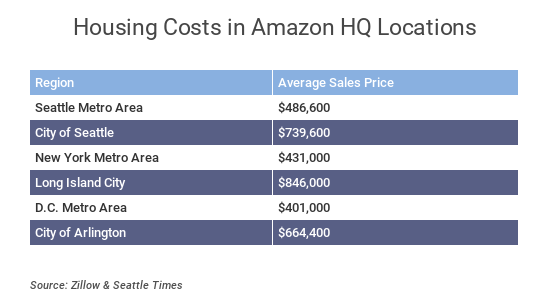Amazon’s Impact on its New HQ2 Cities & the Impact on Seattle
A flurry of news articles have come in the wake of the news that Amazon has officially selected two new HQ cities: one in Long Island City, New York, the other in Crystal City, Virginia. The question on many minds, is how the move will impact the new chosen cities and the company’s relationship to Seattle. As Wall Street Journal outlines, if Seattle is any indication, the arrival “will be transformative.” New infrastructure and restaurants will likely follow, but the Journal says an “invasion of workers will also bring headaches like traffic jams and a jump in housing prices.”
Over the past decade, Amazon has increased its Seattle workforce nine-fold, to 45,000 tech workers. That represents roughly 8% of the city’s total jobs, according to Puget Sound Regional Council. And as the Washington State Department of Revenue outlines, restaurants and food-service businesses have jumped 27% since then.
As has been the case in Seattle, Amazon will put a strain on mass transit in Crystal City and Long Island City. But it could also “mean much-needed upgrades.” In Seattle, for instance, Amazon funded a fourth streetcar to help with congestion amidst packed buses filled with employees. Amazon has also drastically altered the city skyline, as South Lake Union added “a collection of modern office buildings, apartments and teeming restaurants.”
Though Seattle has faced challenges in the wake of the e-commerce giant’s growth, it didn’t deter cities from making their bid for HQ2, with a total of 238 cities submitting proposals for consideration.
And as the Journal points out, “city leaders don’t hide their pride that Amazon calls Seattle home.” Following the HQ2 split news, Mayor Jenny Durkan said it was “good news” and called the new locations “branch offices.” This echoes a recent statement by Realogics Sotheby’s International Realty President & CEO Dean Jones, who said the two-city approach has watered down the economic effects on the future locations and will result in “satellite offices” as opposed to another sprawling campus akin to what they’ve built in Seattle.
So, what’s the implication for Seattle? As Seattle Times reports, “priced-out Seattleites hoping for a housing market crash with Amazon expanding to two new ‘headquarters’ locations might be disappointed.”
Reporter Mike Rosenberg points out that Amazon is already planning 4 million square feet of additional office space for their Seattle outfit, which equals that of its plans for Long Island City and Crystal City. An Emerald City hiring slowdown is not on the horizon either, as there are currently over 8,000 local job opportunities available at Amazon. Given the tech giant’s strong local ties, it isn’t likely that there will be an impact on housing in our region.
Though it hasn’t’ been made clear “how many current and future employees may be able to choose between Seattle and the two new offices,” Rosenberg writes, “the cost of living will be about the same at all three” locations.
As Aaron Terrazas, senior chief economist of Zillow tells the Times, “the fact of Amazon choosing a second (and third) HQ is less important for Seattle’s housing market than their pace of hiring in Seattle moving forward, particularly since they picked two markets that are arguably pricier than Seattle.”
Interviews of current Amazon employees revealed an amount of dismay at the chosen cities. “My wife and I were considering moving to an HQ2 city, but now that it’s official that it’s going to be D.C. and NYC, we have backed off those plans,” one tech worker said.
In addition, Amazon Senior Vice President Jay Carney says employees won’t be required to transfer to either of the new locations. “We continue to have a very strong and long-lasting presence in Seattle — that’s not changing,” he said. “Seattle is and will be (a focus) for a long time.”

